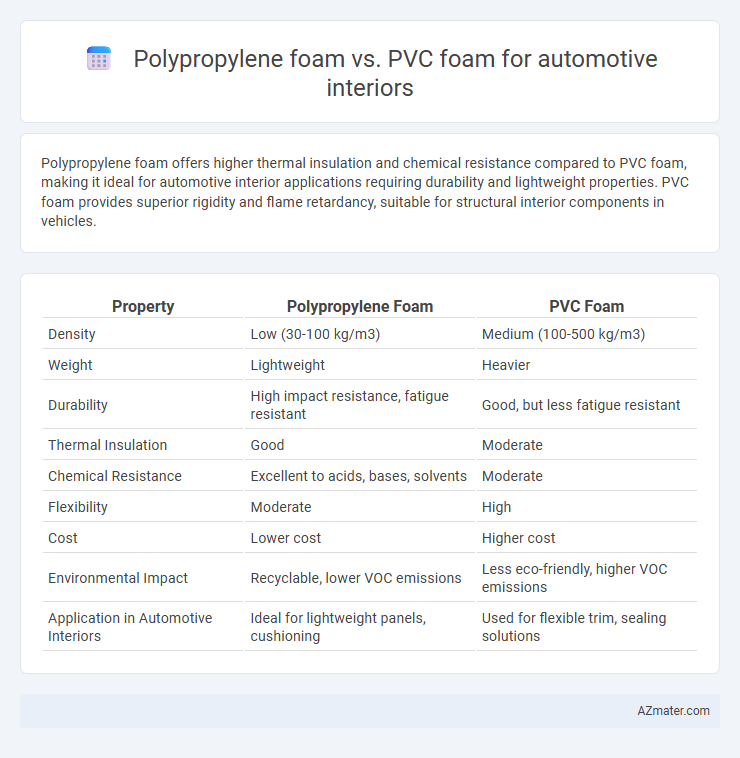Polypropylene foam offers higher thermal insulation and chemical resistance compared to PVC foam, making it ideal for automotive interior applications requiring durability and lightweight properties. PVC foam provides superior rigidity and flame retardancy, suitable for structural interior components in vehicles.
Table of Comparison
| Property | Polypropylene Foam | PVC Foam |
|---|---|---|
| Density | Low (30-100 kg/m3) | Medium (100-500 kg/m3) |
| Weight | Lightweight | Heavier |
| Durability | High impact resistance, fatigue resistant | Good, but less fatigue resistant |
| Thermal Insulation | Good | Moderate |
| Chemical Resistance | Excellent to acids, bases, solvents | Moderate |
| Flexibility | Moderate | High |
| Cost | Lower cost | Higher cost |
| Environmental Impact | Recyclable, lower VOC emissions | Less eco-friendly, higher VOC emissions |
| Application in Automotive Interiors | Ideal for lightweight panels, cushioning | Used for flexible trim, sealing solutions |
Introduction to Automotive Foam Materials
Polypropylene foam and PVC foam are widely used in automotive interiors due to their lightweight, durability, and cushioning properties. Polypropylene foam offers excellent chemical resistance, high impact absorption, and superior thermal insulation, making it ideal for door panels, headliners, and seating components. PVC foam provides enhanced flame retardancy, excellent surface finish, and good sound dampening, often chosen for instrument panels and trim parts to improve vehicle comfort and safety.
Key Properties of Polypropylene Foam
Polypropylene foam offers excellent impact resistance, lightweight characteristics, and superior thermal insulation, making it ideal for automotive interior applications where comfort and durability are essential. Its high chemical resistance and low moisture absorption enhance longevity in vehicle cabins exposed to varying environmental conditions. The foam's recyclability and low density also contribute to improved fuel efficiency and sustainability in automotive manufacturing.
Key Properties of PVC Foam
PVC foam in automotive interiors offers superior chemical resistance, making it ideal for exposure to various solvents and cleaning agents. Its high dimensional stability and flame retardancy comply with stringent automotive safety standards. Additionally, PVC foam provides excellent sound insulation and a smooth surface finish, enhancing both acoustic comfort and aesthetic appeal inside vehicles.
Comparative Durability in Automotive Interiors
Polypropylene foam exhibits higher resistance to chemical exposure and environmental stress cracking compared to PVC foam, making it more durable for automotive interiors subjected to varying temperatures and UV radiation. PVC foam offers excellent paintability and rigidity but tends to degrade faster under prolonged heat and sunlight, leading to potential brittleness and cracking. Choosing polypropylene foam enhances long-term durability and maintains interior aesthetics in demanding automotive environments.
Weight and Density Differences
Polypropylene foam exhibits lower density, typically around 30-70 kg/m3, compared to PVC foam's density range of 60-120 kg/m3, making it significantly lighter for automotive interior applications. This weight advantage contributes to improved fuel efficiency and reduced emissions in vehicles by lowering overall mass. PVC foam, though denser and heavier, offers superior rigidity and better sound insulation, but the lightweight nature of polypropylene foam is preferred for weight-sensitive interior components.
Thermal and Acoustic Insulation Performance
Polypropylene foam offers superior thermal insulation in automotive interiors due to its low thermal conductivity and excellent heat resistance, making it effective at maintaining cabin temperature. PVC foam provides enhanced acoustic insulation by absorbing sound waves and reducing noise transmission, contributing to a quieter driving experience. Both materials balance insulation performance with lightweight properties, but polypropylene foam excels in heat management while PVC foam is preferred for noise reduction.
Environmental Impact and Recyclability
Polypropylene foam in automotive interiors offers superior environmental benefits due to its lower carbon footprint and easier recyclability compared to PVC foam, which contains chloride and releases toxic dioxins during incineration. Polypropylene is fully recyclable through mechanical recycling processes, promoting circular economy practices in automotive manufacturing. PVC foam, while providing good durability, faces significant challenges in disposal and recycling because of hazardous additives and limited recycling infrastructure.
Cost Effectiveness Analysis
Polypropylene foam offers superior cost effectiveness in automotive interior applications due to its lower material and processing costs compared to PVC foam. Its lightweight nature reduces overall vehicle weight, contributing to fuel efficiency and long-term savings. PVC foam, while providing better flame retardancy and rigidity, typically incurs higher expenses in raw material and fabrication, affecting total project budgets.
Common Automotive Applications
Polypropylene foam and PVC foam are widely used in automotive interiors for applications such as door panels, headliners, and armrests due to their lightweight and cushioning properties. Polypropylene foam offers excellent impact resistance and thermal insulation, making it ideal for seating and dashboard components, while PVC foam provides superior chemical resistance and durability in areas exposed to harsh conditions like floor mats and trunk liners. Both materials contribute to enhanced passenger comfort, noise reduction, and overall vehicle weight reduction, which improves fuel efficiency.
Choosing the Right Foam for Your Vehicle’s Interior
Polypropylene foam offers superior lightweight properties and excellent chemical resistance, making it ideal for automotive interior components requiring durability and comfort. PVC foam provides enhanced rigidity and fire retardant capabilities, suitable for structural parts and areas with stringent safety standards. Selecting the right foam depends on balancing the vehicle's design priorities, such as weight reduction, acoustic insulation, and regulatory compliance for interior materials.

Infographic: Polypropylene foam vs PVC foam for Automotive interior
 azmater.com
azmater.com